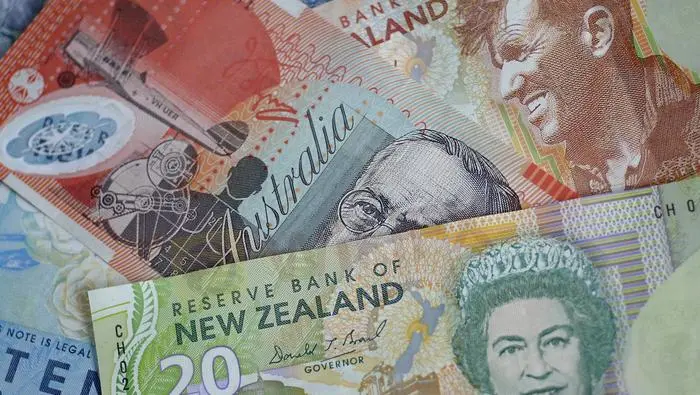简体中文
繁體中文
English
Pусский
日本語
ภาษาไทย
Tiếng Việt
Bahasa Indonesia
Español
हिन्दी
Filippiiniläinen
Français
Deutsch
Português
Türkçe
한국어
العربية
NZD/USD Bull Flag Formation Unravels as September Opening Range Snaps
Abstract:NEW ZEALAND DOLLAR TALKING POINTS
NZD/USD slips to a fresh monthly low (0.7006) as it extends the series of lower highs and lows from last week, and the exchange rate may continue to give back the rebound from the yearly low (0.6805) as the bull flag formation from earlier this month unravels.

NZD/USD BULL FLAG FORMATION UNRAVELS AS SEPTEMBER OPENING RANGE SNAPS
NZD/USD snaps the opening range for September as concerns surrounding Evergrande drag on investor confidence, and a further deterioration in risk appetite may lead to a further decline in the exchange rate as the US Dollar benefits from the flight to safety.
As a result, the US Dollar may continue to outperform its New Zealand counterpart ahead of the Federal Reserve interest rate decision on tap for later this week, and fresh developments coming out of the central bank may keep NZD/USD under pressure if Chairman Jerome Powell and Co. deliver a tentative exit strategy.
Plans to scale back monetary support should prop up the Greenback as Fed officials forecast two rate hikes for 2023, but a more bullish scenario may materialize for the US Dollar if the update to the Summary of Economic Projections (SEP) reflect a steeper path for the federal funds rate.
In turn, NZD/USD may continue to give back the rebound from the yearly low (0.6805) as the bull flag formation from earlier this month failed to transpire, but a further decline in the exchange rate continue to alleviate the tilt in retail sentiment like the behavior seen earlier this year.
The number of traders net-long is 5.91% higher than yesterday and 1.89% higher from last week, while the number of traders net-short is 3.66% lower than yesterday and 29.08% lower from last week. The rise in net-long interest has helped to alleviate the tilt in retail sentiment as 35.19% of traders were net-long NZD/USD last week, while the decline in net-short position comes as the exchange rate slips to a fresh monthly low (0.7006).
With that said, the advance from the August low (0.6805) may turn out to be a correction in the broader trend as NZD/USD trades to fresh yearly lows in the second half of 2021, and the Fed rate decision may undermine the recent recovery in the exchange rate if the central bank shows a greater willingness to normalize monetary policy sooner rather than later.
NZD/USD RATE DAILY CHART

Keep in mind, a head-and-shoulders formation materialized in the first quarter of 2021 as NZD/USD slipped below the 50-Day SMA (0.7006) for the first time since November, with the exchange rate pushing below the 200-Day SMA (0.7116) for the first time since June 2020 to trade to a fresh yearly low (0.6805) in August.
However, NZD/USD reversed course ahead of the November 2020 low (0.6589) amid the failed attempt to close below the 0.6810 (38.2% expansion) region, with a bull flag formation taking shape earlier this month as the exchange rate cleared the July high (0.7105).
Nevertheless, the continuation pattern has failed to materialize as NZD/USD snaps the opening range for September, with lack of momentum to hold above the Fibonacci overlap around 0.7070 (61.8% expansion) to 0.7110 (38.2% expansion) pushing the exchange rate towards the 0.6990 (23.6% retracement) region.
Next area of interest comes in around 0.6940 (50% expansion) to 0.6960 (38.2% retracement) followed by the 0.6870 (50% retracement) region, with a break of the August low (0.6805) opening up the 0.6700 (38.2% retracement) to 0.6710 (61.8% expansion) area.

Disclaimer:
The views in this article only represent the author's personal views, and do not constitute investment advice on this platform. This platform does not guarantee the accuracy, completeness and timeliness of the information in the article, and will not be liable for any loss caused by the use of or reliance on the information in the article.
Read more

Weekly Fundamental Gold Price Forecast: Hawkish Central Banks a Hurdle
WEEKLY FUNDAMENTAL GOLD PRICE FORECAST: NEUTRAL

Gold Prices at Risk, Eyeing the Fed’s Key Inflation Gauge. Will XAU/USD Clear Support?
GOLD, XAU/USD, TREASURY YIELDS, CORE PCE, TECHNICAL ANALYSIS - TALKING POINTS:

British Pound (GBP) Price Outlook: EUR/GBP Downside Risk as ECB Meets
EUR/GBP PRICE, NEWS AND ANALYSIS:

Dollar Up, Yen Down as Investors Focus on Central Bank Policy Decisions
The dollar was up on Thursday morning in Asia, with the yen and euro on a downward trend ahead of central bank policy decisions in Japan and Europe.
WikiFX Broker
Latest News
One article to understand the policy differences between Trump and Harris
Social Media Investment Scam Wipes Out RM450k Savings
FP Markets Received Three Major Awards
Capital One Faces Potential CFPB Action Over Savings Account Disclosures
Malaysian Woman's RM80,000 Investment Dream Turns into a Nightmare
M2FXMarkets Review 2024: Read Before You Trade
FX SmartBull Review! Read first, then Invest
Bangladesh steps up payments to Adani Power to avoid supply cut
Bitcoin.com Introduces Venmo for U.S. Bitcoin Purchases via MoonPay
What Happened to NFTs?
Currency Calculator


